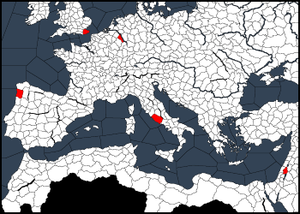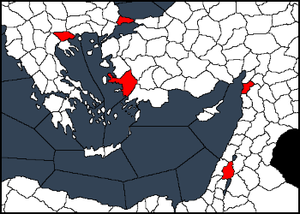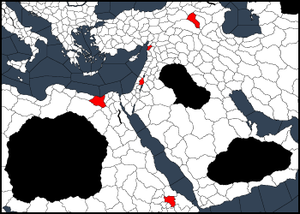Christianity is one of the 6 religious groups represented in ![]() Crusader Kings II, and the only group playable without paid expansions (though its mechanics are expanded by
Crusader Kings II, and the only group playable without paid expansions (though its mechanics are expanded by ![]() Sons of Abraham).
Sons of Abraham).
The second of the Abrahamic religions, Christianity arose from the teachings of Yeshua of Nazereth, a Jewish carpenter commonly called by his Greek name Jesus, whom Christians believe to be the literal Son of God. Though Jesus was crucified in approximately 30 AD on the orders of Pontius Pilate, the Roman governor of Judea, at the behest of the Jewish High Priesthood, the faith he founded would ultimately supplant Hellenic paganism as the state religion of the Roman Empire following its legalization by Emperor Constantine I in 313. By the time of Crusader Kings II, Christianity is the dominant religion in Western and Central Europe, as well as in the Byzantine Empire and East Africa, and its reach continues to expand in later start dates by the conversion of West Asian pagans and the Spanish Reconquista.
There are four groups of Christians present in CKII: Roman Catholicism, Eastern Orthodoxy, Miaphysitism (also known as Copticism), and Nestorianism.
Common features
For all Christian religions:
- Marriage is expected to be monogamous, as in Judaism. Christianity does not normally feature any form of polygamy, though Christian tribal rulers can still take concubines.
- Temples are called "churches" and their holders are called "bishops".
- Disinherit a character by granting a temple (similar to Indian religions) or ordering to take the vows
- Improved spread rate compared to other faiths, reflecting Christian evangelism.
- Unique decisions:
- Hold a Summer Fair
- Go on a Pilgrimage (requires Sons of Abraham DLC; if Way of Life DLC active, the Theology focus)
- Restore the Roman Empire (requires Legacy of Rome DLC)
- Unique trait effects:
 and
and  : +5 opinion from Christian churchmen
: +5 opinion from Christian churchmen and
and  : -5 opinion from Christian churchmen
: -5 opinion from Christian churchmen
- Pious characters have a chance to be beatified or attain sainthood. (requires Holy Fury DLC)
Most Christian religions feature a religious head with the following interactions:
- Excommunicate a character (100 piety), making them disliked and vulnerable to the Excommunicated Ruler CB
- Grant divorce (100 piety)
- Sanctioned Invasion CB, grantable against any stronger ruler or any ruler whose title you have a claim on, should the Pope not like him (1000 piety)
The concept of a character's religious head is especially important for Christians as many characters may not have the same religious head even though they follow identical religions, due to (potential) antipopes and autocephaly.
Catholicism is the major religion of Western Europe. After each start date, it has a tendency to progress further east, and is almost always one of the most successful religions in the game.
Catholicism is one of the major instigators of the Great Schism. The Great Schism was a separation of the original Nicene Church after a prolonged rivalry between the Roman Pope and the Constantinopolan Ecumenical Patriarch, culminating in them excommunicating each other shortly before the "Stamford Bridge" game start (in 1054).
The religious head for Catholicism is the Pope, but it is not uncommon for one or more Antipopes to form throughout the game.
- Bishops who like the Pope (or Antipope) more than their secular liege will shirk their duties as vassals. They will pay taxes to the Pope (or Antipope) and provide levies to nobody.
- College of Cardinals, a special mechanism that determines how Popes are replaced
- Investiture, a special crown law that determines how bishops are replaced
- Papal Investiture halves the piety cost of religious head interactions, at the cost of not being able to appoint successors to bishoprics
- Free Investiture improves vassal opinion, harms pope opinion, and allows appointing an antipope, as well as successors to bishoprics
- Numerous papal favors that rulers can request
- The only Christian denomination where crusades can be called against heretics and infidels. The Fraticelli heresy also features crusades if its religious head is created.
- Catholicism and its heresies become heresies of Orthodoxy when an Orthodox character mends the Great Schism. If this happens, crusades are disabled, even if Catholicism (or Fraticellism) becomes the mainstream.
- With
 Holy Fury, Catholic kings and emperors are highly encouraged to hold a Coronation ceremony to legitimize their rule.
Holy Fury, Catholic kings and emperors are highly encouraged to hold a Coronation ceremony to legitimize their rule.
Once the Crusades are unlocked, Catholicism gains more holy orders than any other religion in the game (up to five if their formation conditions are met). With ![]() Monks and Mystics, Catholicism gains two monastic orders, the Benedictines and the Dominicans.
Monks and Mystics, Catholicism gains two monastic orders, the Benedictines and the Dominicans.
Catholicism's holy sites are:
- Rome: The seat of the Pope and historical capital of the Western Roman Empire.
- Santiago: The site of the tomb of St. James the Great, one of the Twelve Apostles of Christ.
- Köln: The site of the Shrine of the Three Kings, a reliquary said to contain the bones of the three wise men from the East who visited the young Christ in the Gospels.
- Jerusalem: Holy to all Abrahamic faiths, Jerusalem is the historical seat of the Jewish faith and the site where Christ was executed and rose from the dead.
- Kent: The Archbishopric of Canterbury is of great importance in British Christianity from antiquity into the Renaissance. Among other things, it was the see of St. Thomas Becket, who was murdered by followers of King Henry II Plantagenet in 1170 AD (the infamous "turbulent priest" incident, emblematic of the tension between secular and clerical rulers in Catholicism).
Santiago and Jerusalem are under Muslim control in the early start dates, which makes Catholicism's moral authority rather vulnerable. In a 769 game in particular, due to the fact that Karl of West Francia often dies before forming Francia or the Holy Roman Empire, it's not uncommon to see Rome be captured by a Viking adventurer. This causes MA to plummet (-10 for losing the holy site and -5 for the Pope not controlling it). This in turn tends to result in heresy outbreaks across Western Europe, tearing its already relatively weak realms apart and making them easy prey for the Umayyads.
Heresies 
- Fraticellism has identical mechanics to Catholicism, but the Fraticelli Pope (if created by a Fraticelli ruler who controls the county of Rome) is a duke-rank title. This means he may be vassalized by a mere king instead of only by an emperor as is the case with the Catholic Pope.
- Catharism does not have a religious head or crusades, but allows female bishops and absolute cognatic succession law and has no penalties for female rulers or heirs. Bishoprics are filled by absolute cognatic open elective.
- Lollardy and Waldensianism lack a religious head and crusades. Bishoprics are filled by agnatic open elective.
Eastern Orthodoxy is the religion of the Byzantine Empire and several of its neighbors. In 1066, it is also the religion of the Rurikid rulers (Rus-Ruthenia region).
The Byzantine Empire is by far the most powerful Orthodox ruler in most start dates. However, its rule is often challenged by heresy (notably Iconoclasty in 769) and powerful Muslim rulers.
The religious head of Eastern Orthodoxy is the Ecumenical Patriarch, usually residing in Constantinople. However, he only has jurisdiction over characters and provinces not already under pentarchs and autocephalous patriarchs. Most of the time, the Ecumenical Patriarch is also the Pentarch of Constantinople, and a vassal of the Byzantine Empire.
- At game start, the only autocephalous religion with multiple kings
- The only religion with a dangerous heresy at any start date (Iconoclasm in 769)
- Mend the Great Schism to re-unite the Catholic and Orthodox religions if an Orthodox ruler owns Rome, Constantinople, Antioch, Jerusalem, and Alexandria as well as having the Ecumenical Patriarch as a vassal
- If the Byzantine Empire does not exist, it can only be created by Orthodox rulers
- The commander of the Varangian Guard will only convert to Orthodoxy (and not an Orthodox heresy)
The Orthodox faith gains a holy order, the Brotherhood of the Holy Sepulchre, if Antioch and Jerusalem are majority Orthodox and controlled by Orthodox characters. In Monks and Mystics they also have a monastic order, the Community of St. Basil.
Orthodoxy's holy sites are:
- Constantinople: The historical seat of the Ecumenical Patriarchate and Emperor Constantine's capital. Constantine is venerated as a saint by Orthodoxy and by Byzantine Catholics.
- Jerusalem
- Antioch: Referred to as the "Cradle of Christianity" and the place where the word "Christian" first emerged.
- Ephesus: An important center of early Christianity.
- Mount Athos: The heart of Eastern monasticism.
Heresies 
- Iconoclasm is functionally identical to mainstream Orthodoxy, though an Iconoclast Byzantine Emperor cannot request that the commander of the Varangian Guard convert to it. In the 769 bookmark, the emperor follows this heresy and the Iconoclast Patriarch rules in place of the Ecumenical Patriarch. The Iconoclast Patriarchate does not exist in other starts.
- Bogomilism has no religious head nor autocephaly. It permits female bishops and has no penalties for female rulers or heirs, though not absolute cognatic succession law.
Other heresies follow the same mechanics as mainstream Orthodoxy, but have their own always-existent patriarchs.
Miaphysite Christianity, sometimes known as Oriental Orthodoxy or Coptic Christianity, is a religion that arose in opposition of the Council of Chalcedon's decision of Christ being "of two natures". Once spreading across the Byzantine Empire's non-Greek land as well as the Kingdoms of Armenia, Nubia, and Abyssinia, its spread has been significantly hampered by the Islamic expansion and is in danger of being wiped out.
The religious head of Miaphysitism is the Coptic Pope. However, like the Ecumenical Patriarch, he only has jurisdiction over a relatively small amount of characters and land. More info here. The Coptic Pope is often also the Bishop of Alexandria, if it is controlled by Miaphysite lords.
- Autocephaly
- Relative minority religion, with most characters of the religion being independent counts and dukes in Eastern Africa, as well as some rulers in or near Armenia
Miaphysitism gains a holy order, the Order of Saint Anthony, if Alexandria, Makuria, and Axum are Miaphysite and owned by Miaphysite characters. With Monks and Mystics it also has a monastic order, the Community of Saint Anthony.
Miaphysitism's holy sites are:
- Alexandria: Historical seat of the Coptic Papacy. Pope Dioscorus I of Alexandria, who was deposed by the Council of Chalcedon, is recognized as the first Patriarch of the Coptic Church.
- Aksum: Location of the Church of Our Lady Mary of Zion where the Ark of the Covenant is kept.
- Antioch: Severus of Antioch was the last Monophysite Patriarch of Antioch and is venerated as a saint in Miaphysitism.
- Jerusalem
- Dwin: Location of the Cathedral of Saint Grigor, the largest Christian church in Armenia at the time it was built.
- Alexandria, Antioch and Jerusalem are important

 Silk Road counties.
Silk Road counties.
- Alexandria, Antioch and Jerusalem are important
Miaphysitism's heresy Monophysitism ![]() is mechanically identical to the mainstream religion.
is mechanically identical to the mainstream religion.
Nestorianism is a minority religion that arose in opposition of the Council of Ephesus and Council of Chalcedon's decision of Christ being "of two natures". The religion is in isolated areas near Baghdad and on Socotra in early starts in 1066. Nestorianism once was a significant influence in the Eastern world, with many adherents in Central Asia, including many Mongols, and spreading as far as China and India. However, it almost completely collapsed in the 14th century due to the destruction of Timur's conquests and Islamic and Ming dynasty persecution. There are few Nestorian starts and they will, as is somewhat historical, most likely be wiped out by expansionist Muslims or Mongols. There are also two horde Khagans that follow this faith themselves, those of the Golden Horde and Ilkhanate in 1255 and 1260 respectively; historically, this was most likely the basis for the myth of Prester John.
- Has a religious head: the Patriarch of the East
- Minority religion; has 23 provinces following the religion in 769 start date.
- Can intermarry Taoist, Bön, Buddhist, and all religions in the Zoroastrian group.
- Prior to 2.8 patch, the Nestorians used to have Autocephaly head system like the other non-Catholic Christian branches before reworked to have their own religious head system which is very similar to Papacy but without Papal succession mechanic.
A Nestorian ruler can form a holy order if he controls at least one holy site and Nestorianism has at least 50% Moral Authority. With Monks and Mystics it has a monastic order, the Community of Saint Abraham.
Nestorianism's holy sites are:
- Edessa: Location of the School of Edessa and birthplace of Nestorianism.
- Baghdad: Seat of the Nestorian Patriarch from 775 to ~1310.
- Merv: Important metropolitan site between the 5th and 11th centuries. Merv's Christian community started from Christians deported from Roman territory at the beginning of the 5th century.
- Jerusalem
- Mahoyadapuram: Burial site of Thomas the Apostle. Saint Thomas is traditionally believed to have sailed to India in AD 50. A large Nestorian community grew around his tomb.
- Almost all Nestorian holy sites are important

 Silk Road counties, except Edessa.
Silk Road counties, except Edessa.
- Almost all Nestorian holy sites are important
Due to the typical lack of moral authority it is relatively easy and harmless to convert from Nestorianism to its heresy.
Heresies 
- Messalianism has the Divine marriage feature, permitting and encouraging marriages to one's own siblings, parents, or children. It lacks a religious head, and allows absolute cognatic succession and has no penalties for female rulers or heirs.



